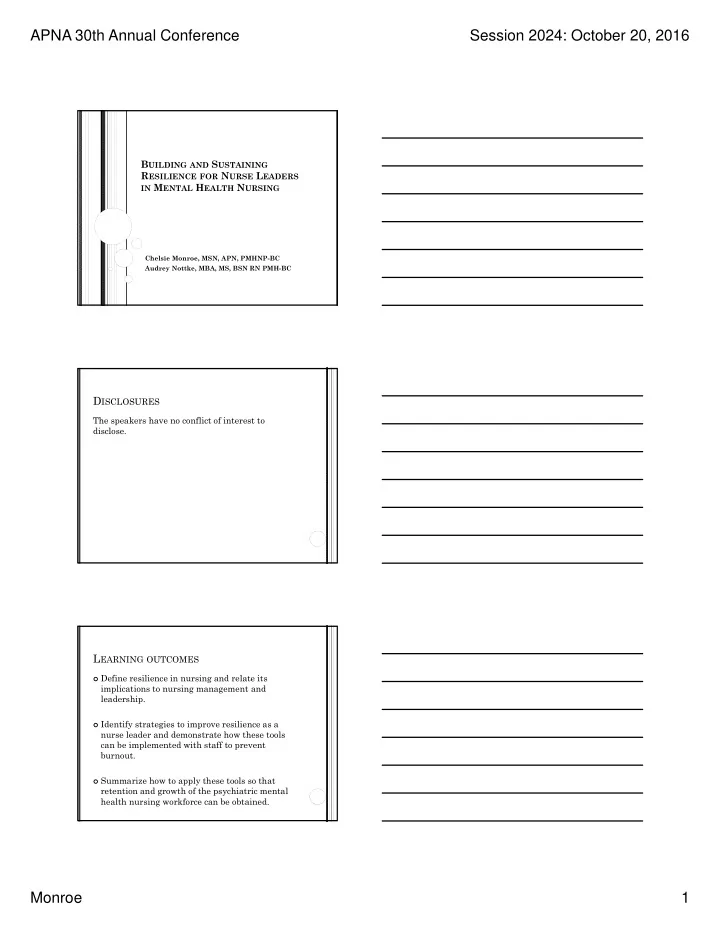

APNA 30th Annual Conference Session 2024: October 20, 2016 B UILDING AND S USTAINING R ESILIENCE FOR N URSE L EADERS IN M ENTAL H EALTH N URSING Chelsie Monroe, MSN, APN, PMHNP-BC Audrey Nottke, MBA, MS, BSN RN PMH-BC D ISCLOSURES The speakers have no conflict of interest to disclose. L EARNING OUTCOMES Define resilience in nursing and relate its implications to nursing management and leadership. Identify strategies to improve resilience as a nurse leader and demonstrate how these tools can be implemented with staff to prevent burnout. Summarize how to apply these tools so that retention and growth of the psychiatric mental health nursing workforce can be obtained. Monroe 1
APNA 30th Annual Conference Session 2024: October 20, 2016 W HAT IS RESILIENCE ? Definition: the ability to survive and thrive in the face of adversity (Cline, 2015). Resilience has been identified as an important attribute of authentic leadership and employee engagement (Cline, 2015). It has been shown to increase longevity and satisfaction in leadership roles and staff retention (Cline, 2015 & Wicks, 2006). H EALTHCARE CULTURE Western healthcare culture – stress induced Increase in crises with reduction in resources Information overload, rapid advances in technology Nurse managers are tasked to become patient centered but must also drive quality, safety, and satisfaction metrics and remain a fiscal steward of the organization (Mac Leod Dyess, Prestia, Smith, 2015). The Nurse Manager role is perceived as overwhelmingly stressful (Shirey, 2004). What drove us to become nurse leaders? Various stressors compete against each other, causing nurse leaders frustration, emotional distress, anxiety, and apprehension (Stagman-Tyrer, 2014). Stress impact individual and organizational performance, interpersonal communication, nursing recruitment, and retention rates (Pipe, Bortz, & Dueck, 2009). Monroe 2
APNA 30th Annual Conference Session 2024: October 20, 2016 E FFECTS OF STRESS ON NURSES Health effects: Sympathetic response Cellular aging Anxiety, depression Eventual rather than immediate Work satisfaction/staff satisfaction Patient satisfaction scores Poor patient outcomes Ultimately turnover or attrition (Mac Leod, Prestia, Smith, 2015, Wicks, 2006, & Cline, 2015) Further exacerbate nursing shortage (Wicks, 2006) The question is not whether stress will appear and take a toll on those working in healthcare; it is to what extent do professionals take essential steps to appreciate, minimize, and learn from this stress to continue – and even deepen – their roles as helpers and healers (Wicks, 2006). A literature review is used to summarize the common themes in building a resilient nurse leader and staff. Key words included: Nurse leader resiliency Mental health nurse resiliency Burnout Compassion fatigue Secondary stress Nursing leader roles Resilience Self care Mental health nursing leadership Stress management Monroe 3
APNA 30th Annual Conference Session 2024: October 20, 2016 Q UALITIES OF A RESILIENT NURSE LEADER Honesty & Integrity Accountability Integrity Authenticity Hope Optimism Inspirational Considerate Equanimity Courage Self reliance Perseverance I NTERVENTIONS TO IMPROVE LEADER NURSE LEADER RESILIENCY Rethink how you define success Balance between humanism and bureaucracy (Mac Leod Dyess, Prestia, & Smith, 2015) Collaboration within organization and community Shared leadership model Regulate mood and affect, balance sympathetic response and awareness of triggers Know who you are and what you stand for Acknowledge lessons and be willing to try again (Cline, 2015) Avoid perfectionism Workaholics beware! Increase vulnerability and risk Self care Self reflection Ask for what you need, clarify expectations Monroe 4
APNA 30th Annual Conference Session 2024: October 20, 2016 Anticipate responses to adverse events and role play Seek out feedback, receive graciously, and incorporate suggestions in a visible way (Cline, 2015) Incorporate Jean Watson’s caring theory into practice Time management and scheduled personal time Mindfulness Develop relationships and build social support network H OW DO WE IMPART RESILIENCY ON OUR STAFF ? Remove barriers that prevent staff from doing their job Focus on culture, education, staff development, flexibility, clinical improvement and professional standards in order to change mental health services (Holm & Severinsson, 2010). Follow values Keep commitments Insist on a culture that demonstrates positive attitudes and looks for lessons in adverse experiences (Cline, 2015). Demonstrate what data means to staff Employee rounding Put the patient first. Ask yourself, “where is the patient in this decision?” (Mac Leod Dyess, Prestia, & Smith, 2015). Senior staff members coach and mentor new staff (Cline, 2015) Monroe 5
APNA 30th Annual Conference Session 2024: October 20, 2016 Reinforce positive behavior Don’t tolerate low performers Role clarity Assert shared governance and encourage creative problem solving (Cline, 2015) Stop chasing the scores Provide opportunity for venting Spontaneously reward staff when spirits are high or low (Wicks, 2006) Compliment staff in front of colleagues, supervisors, and patients Show personal concern for staff Advocate for nursing W HY DOES IT MATTER ? Nurse leaders who are intentional in cultivating and applying resilience will find that their relationships and leadership capabilities are enhanced and strengthened during challenging times (Cline, 2015). Benefits of resilience in a nurse leader (Cline, 2015): Increase in longevity and satisfaction in leader roles Greater work engagement from staff Reduced staff turnover Reduced cost Improve quality outcomes through organizational mindfulness Monroe 6
Recommend
More recommend